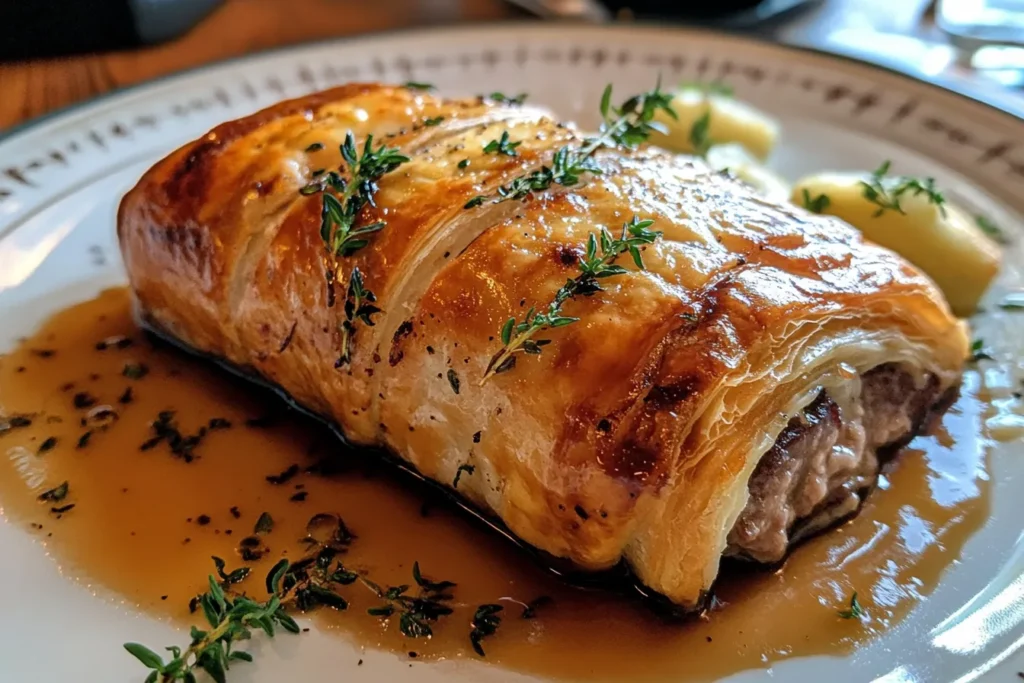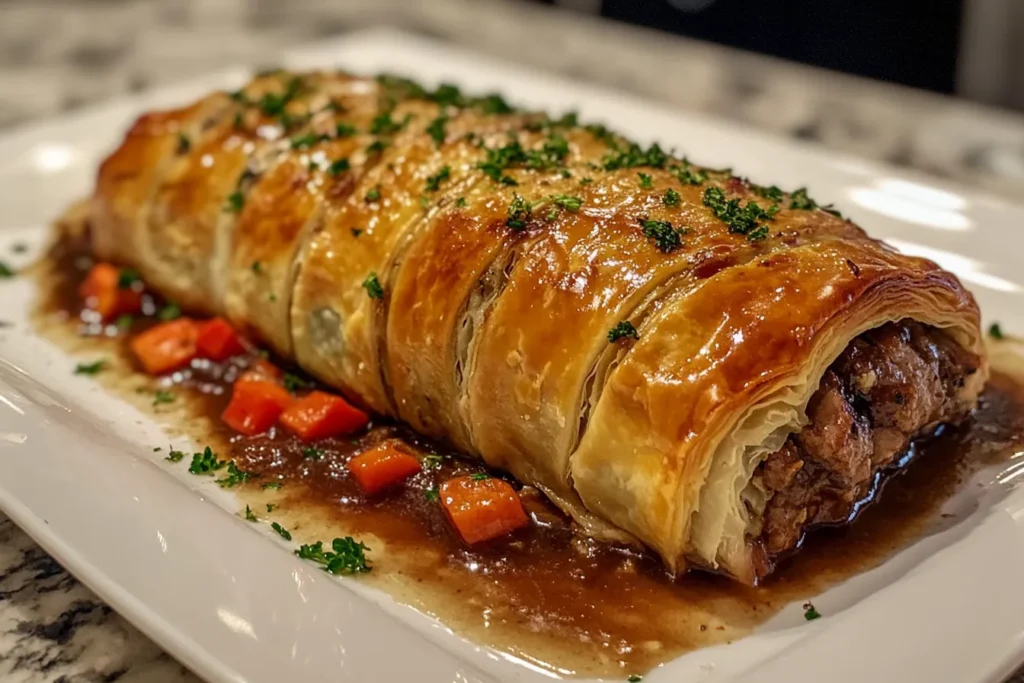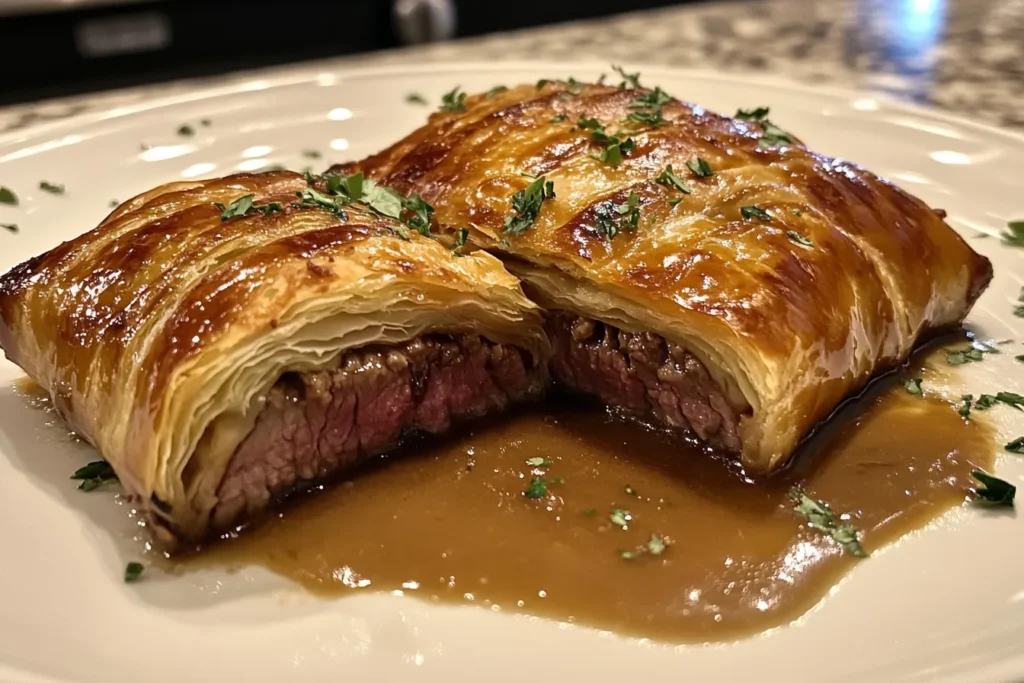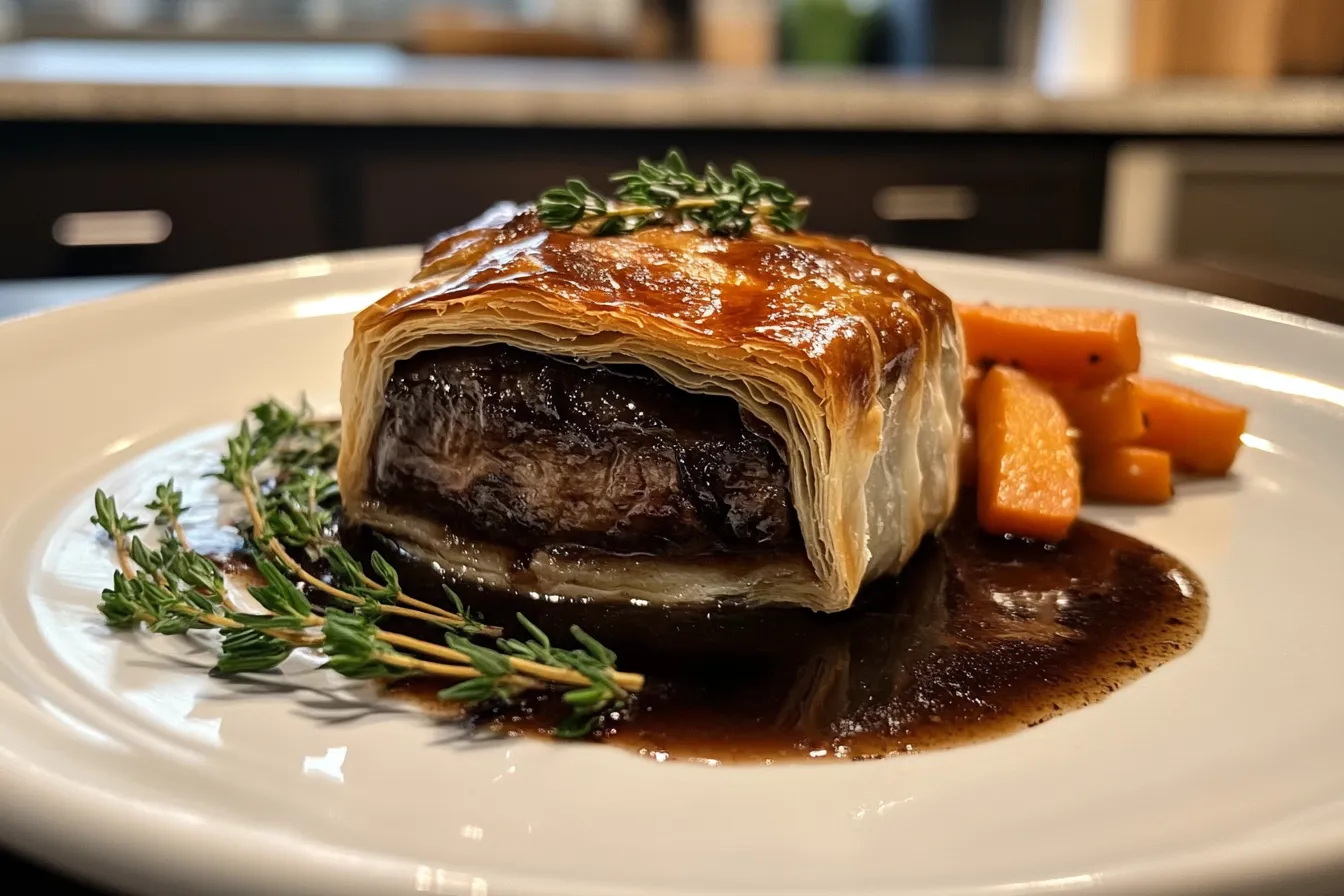Have you ever poured your heart into making Beef Wellington, only to cut into it and find a soggy mess instead of the perfect, golden crust you dreamed of? Don’t worry—you’re not alone! Preventing a soggy Beef Wellington is a common challenge, but with the right techniques, you can ensure a crispy, flaky pastry that wraps your tender beef like a masterpiece. I remember the first time I attempted this iconic dish—I was so excited, but when I sliced into it, the bottom was a disaster. It was frustrating, but I learned some game-changing tips along the way. If you’ve struggled with this too, let’s tackle the problem together and make your next Beef Wellington a showstopper!
List Of Contents
1. Introduction to Beef Wellington
Beef Wellington is celebrated for its contrasting textures—a tender beef center wrapped in mushroom duxelles, prosciutto, and golden puff pastry. The crispness of the pastry is essential for balancing the rich flavors of the beef and filling.
However, achieving the perfect texture can be tricky. Excess moisture from the ingredients or improper cooking techniques often leads to sogginess.
To make this dish stand out, it’s crucial to focus on both preparation and execution.
2. Why Does Beef Wellington Become Soggy?
Several factors contribute to sogginess in Beef Wellington, including:
- Excess Moisture: Water released from the beef, mushrooms, or puff pastry can ruin the texture.
- Improper Techniques: Overlapping layers, undercooking, or lack of resting the beef often lead to a soggy result.
The key to a successful Wellington is understanding how moisture behaves during cooking. Addressing these factors early in the preparation process can make all the difference. Check out sweet recipes here.
3. The Role of Ingredients in Texture

Ingredients play a significant role in the outcome of Beef Wellington:
- Beef: If not properly dried or prepped, the beef can release too much moisture into the pastry.
- Mushrooms for Duxelles: Wet or improperly cooked mushrooms add excess liquid, soaking through the pastry.
A proactive approach—such as drying and properly cooking ingredients—ensures a balanced texture.
4. Significance of Puff Pastry in Texture
The puff pastry is the crown jewel of Beef Wellington. Its light, flaky layers provide a crisp shell that complements the soft interior. When the pastry becomes soggy, it compromises the dish’s overall flavor.
Key considerations for puff pastry:
- Choose high-quality puff pastry for better results.
- Ensure consistent rolling to prevent uneven cooking.
- Properly seal edges to maintain structure and crispness.
5. Role of Cooking Techniques in Sogginess
Cooking techniques can make or break your Beef Wellington. Issues like overbaking, underbaking, or failing to properly sear the beef often lead to sogginess.
- Overbaking: The pastry absorbs moisture as it stays in the oven too long.
- Underbaking: The layers don’t cook through, leaving raw dough at the bottom.
Balancing doneness across the layers is essential for a crisp and golden exterior.
6. Prepping the Beef for the Wellington
A common mistake is not drying the beef thoroughly before searing. Excess moisture from the beef can seep into the pastry during baking.
To avoid this:
- Thoroughly dry the beef using a clean kitchen towel or paper towel before searing to remove surface moisture effectively.
- Let the beef rest after searing to allow juices to redistribute, reducing liquid release.
These steps ensure the pastry stays crisp and flakey.
7. Prepping the Mushrooms for Duxelles
Mushroom duxelles, a savory filling made from finely chopped mushrooms, adds depth of flavor to Beef Wellington. However, mushrooms naturally contain a lot of water, which can lead to sogginess.
Here’s how to perfect the duxelles:
- Cook the mushrooms on medium heat until all the liquid evaporates.
- Avoid using too much oil, which can make the mixture greasy.
A paste-like consistency is ideal for reducing moisture transfer to the pastry.
8. Wrapping the Beef with Prosciutto
Prosciutto serves as a moisture barrier, preventing juices from the beef and duxelles from soaking into the pastry. However, uneven wrapping can lead to weak spots in the Wellington.
Tips for wrapping:
- Use thin slices of prosciutto and overlap them slightly.
- Wrap the beef tightly, ensuring full coverage to contain moisture.
This step acts as an essential safeguard against soggy pastry.
9. Cooling and Resting the Components
Cooling components before assembly is critical. Warm fillings or beef can prematurely heat the pastry, causing it to lose its structure.
Best practices for cooling:
- Chill the seared beef thoroughly before assembly.
- Let the duxelles cool completely before spreading it on the pastry.
By starting with cool ingredients, you can maintain the integrity of the puff pastry during baking.
10. Challenges with Assembling Beef Wellington
Layering ingredients improperly or rushing the assembly process can lead to a soggy mess.
Common challenges include:
- Uneven distribution of duxelles, which creates wet patches.
- Overlapping layers of prosciutto or pastry that trap moisture.
To avoid this, assemble the Wellington with care, ensuring each layer is smooth and evenly spread.
Techniques to Prevent Sogginess
11. Dry-Searing the Beef
Dry-searing is a crucial step in preparing Beef Wellington. It creates a caramelized exterior, locking in flavor while reducing excess moisture.
Steps to dry-sear effectively:
- Heat a heavy-bottomed pan until very hot but not smoking.
- Avoid adding oil to the pan; instead, lightly coat the beef with oil.
- Sear the beef on all sides until a deep, golden crust forms.
Why it works:
A dry-seared crust helps contain the beef’s natural juices, minimizing moisture release into the pastry.
12. Perfecting the Duxelles
The duxelles is a key flavor element, but its moisture content can cause sogginess if not handled correctly.
How to perfect your duxelles:
- Use finely chopped mushrooms for even cooking. A food processor works best for consistency.
- Cook the mushrooms on medium heat without oil initially to release water.
- Once the liquid evaporates, add a small amount of butter or oil for flavor, but avoid excess.
Pro Tip:
A properly cooked duxelles should resemble a thick, paste-like consistency. Spread it thinly to avoid overwhelming the pastry.
13. Using Egg Wash for the Pastry
The egg wash serves two purposes: sealing the edges of the puff pastry and giving it a golden, crisp finish.
Tips for applying egg wash:
- Use a beaten egg or egg yolk mixed with a splash of milk or cream.
- Apply the wash with a pastry brush evenly across the surface.
- Avoid overloading with the egg wash, as it can drip and stick to the baking tray.
Why it’s important:
Proper egg wash application ensures the puff pastry cooks evenly and remains crisp.
14. Layering Ingredients with Care
Strategic layering during assembly is essential to prevent moisture from seeping into the pastry.
Key strategies:
- Place the mushroom duxelles evenly over the prosciutto.
- Avoid overlapping the prosciutto; instead, create a seamless layer.
- Wrap the beef tightly with the prosciutto and duxelles to minimize gaps where moisture can accumulate.
Result:
Careful layering keeps the pastry dry and maintains the structure of the Wellington.
15. Choosing the Right Puff Pastry

Not all puff pastries are created equal. High-quality puff pastry ensures a better result, while poor-quality options can become gummy and soggy.
What to look for:
- Choose puff pastry with a high butter content for better flakiness.
- Ensure it’s thawed but still cold when working with it.
- Roll the pastry to an even thickness to prevent uneven cooking.
Pro Tip:
Avoid overly thick pastry layers, as they may not cook through, leading to sogginess.
16. Chilling Between Steps
Chilling the components between steps is vital for maintaining structural integrity during baking.
Why chilling works:
- It prevents the puff pastry from becoming too warm and sticky.
- Allows the duxelles and beef to firm up, making assembly easier.
Best practices:
- After wrapping the beef in prosciutto, chill it in the refrigerator for at least 30 minutes.
- Chill the assembled Wellington for another 30 minutes before baking.
This ensures the puff pastry maintains its layers during baking.
17. Baking on a Raised Surface
Baking on a flat tray can trap heat and moisture underneath, leading to a soggy bottom.
Solutions for better airflow:
- Use a wire rack or a perforated baking tray to allow heat to circulate underneath the pastry.
- Line the rack with parchment paper to prevent sticking.
Result:
The puff pastry cooks evenly and remains crisp on all sides.
18. Preheating the Oven
An improperly preheated oven can ruin your Beef Wellington. Starting with a cold oven causes the pastry to cook unevenly, absorbing moisture rather than crisping.
Oven tips:
- Preheat your oven to 400°F (200°C) or the temperature specified in your recipe.
- Allow the oven to reach the set temperature fully before placing the Wellington inside.
Why it matters:
A hot oven activates the puff pastry’s layers immediately, ensuring a light, flaky crust.
19. Avoiding Steam Build-Up During Baking
Trapped steam can soften the pastry, resulting in a soggy Wellington. To prevent this:
- Avoid covering the Wellington with foil during baking.
- Leave a small gap between the pastry and the baking tray to allow steam to escape.
- If using a convection oven, turn on the fan for better airflow.
Outcome:
The puff pastry remains dry and crisp, while the filling cooks perfectly.
20. Resting the Wellington After Baking
Resting is a crucial but often overlooked step. It allows the juices to redistribute, preventing them from seeping into the pastry when sliced.
How to rest the Wellington:
- Remove it from the oven and let it sit on a wire rack for 10–15 minutes.
- Avoid covering it, as this can trap residual steam.
Why it’s effective:
Resting ensures that each slice maintains its crisp exterior without being soaked by residual juices.
Additional Tips for Success
- Use a meat thermometer to ensure the beef is cooked to your desired level of doneness without overcooking the pastry.
- If your Wellington does become slightly soggy, reheat it in the oven at a high temperature for a few minutes to restore crispness.
Troubleshooting and Additional Tips
21. Identifying Issues During Preparation
Spotting moisture problems early can save your Beef Wellington from becoming soggy.
Signs of potential issues:
- Wet mushrooms in duxelles: If the mixture remains watery during cooking, extend the sautéing process to evaporate the liquid fully.
- Runny beef juices after searing: Let the beef rest longer to release residual juices.
- Sticky puff pastry: If the pastry is hard to handle, it may be too warm. Chill it for a few minutes to restore firmness.
Mid-process adjustments:
- Dry any wet spots with paper towels before continuing assembly.
- If the duxelles feels too wet, spread it out on a parchment-lined tray and briefly bake it at a low temperature to dry it out.
22. Correcting Sogginess After Baking
If you discover your Beef Wellington is soggy post-baking, there are still ways to salvage it.
Quick fixes:
- Reheat the Wellington in a hot oven (425°F/220°C) on a wire rack for 5–7 minutes to crisp up the pastry.
- Avoid microwaving, as it can make the pastry even soggier.
- If the sogginess is severe, consider serving slices with a crisp side dish like roasted potatoes to balance the texture.
23. Alternative Methods for Assembling Beef Wellington
For those looking to minimize the risk of sogginess altogether, consider alternative assembly methods.
Innovative ideas:
- Use phyllo pastry: This lighter pastry has thinner layers and is less prone to sogginess when baked correctly.
- Open-faced preparation: Skip the top pastry layer for a tart-like presentation that reduces trapped steam.
- Deconstructed Beef Wellington: Serve the components (beef, duxelles, and puff pastry) separately for a modern twist.
Why it works:
These methods offer creative solutions while retaining the dish’s signature flavors.
24. Expert Tips from Chefs

Professional chefs have perfected techniques to avoid soggy Wellington. Here are their insights:
- Gordon Ramsay: Focus on even rolling of the pastry and proper searing to create a moisture barrier.
- Thomas Keller: Layer the prosciutto and duxelles thinly to maintain the integrity of the puff pastry.
- Ina Garten: Chill each layer before assembly to ensure the pastry stays firm during handling.
These expert-approved methods have been tested in high-pressure kitchens, making them reliable for home cooks.
25. Ingredient Substitutions to Reduce Moisture
Certain ingredients can be swapped to decrease overall moisture levels.
Low-moisture alternatives:
- Use dry-aged beef for less water content.
- Replace traditional mushrooms with firmer varieties like portobello or cremini for duxelles.
- Opt for par-cooked spinach instead of mushrooms for a drier filling.
Impact of substitutions:
These swaps help create a drier, more manageable filling while preserving flavor.
26. Best Tools for Preparation
Having the right tools can significantly improve the outcome of your Beef Wellington.
Must-have tools:
- Digital meat thermometer: Ensures accurate internal temperature without overcooking.
- Perforated baking tray or wire rack: Promotes even airflow for a crisp bottom crust.
- Rolling pin with thickness guides: Helps achieve consistent pastry thickness for even cooking.
Bonus Tip:
Invest in high-quality non-stick parchment paper to prevent sticking without adding moisture.
27. Pairing Side Dishes to Complement Texture
The side dishes served with Beef Wellington should enhance its textures rather than add extra moisture.
Perfect accompaniments:
- Roasted vegetables: Crisp green beans or caramelized Brussels sprouts balance the dish.
- Crispy potatoes: Serve with roasted fingerling or smashed potatoes for a crunchy side.
- Light salads: A simple arugula salad with vinaigrette adds freshness without heaviness.
Avoid heavy sauces that can saturate the pastry. Opt for reductions or jus served on the side.
28. Common Myths About Beef Wellington Sogginess
Some common myths about soggy Beef Wellington can mislead cooks. Let’s debunk them:
- “Adding flour to the duxelles helps absorb moisture.”
False: This can create a pasty texture and doesn’t address excess liquid effectively. - “It’s better to assemble the Wellington on a separate surface and transfer it to the baking tray to avoid sticking and ensure proper handling.”
- False: Transferring the assembled Wellington after chilling ensures a better seal and reduces sticking.
- “More egg wash is better for crispness.”
False: Over-applying egg wash can make the pastry sticky and lead to uneven browning.
Understanding these myths ensures you follow proven practices for a crisp result.
29. Preparing Beef Wellington in Advance
Making Beef Wellington ahead of time can save stress, but it requires proper storage techniques to maintain quality.
Steps for advance preparation:
- Assemble the Wellington up to 24 hours before baking, but do not add egg wash until just before baking.
- Store the assembled Wellington on a parchment-lined tray, covered loosely with plastic wrap, in the refrigerator.
- Bake directly from chilled, adding an extra 5–10 minutes to the cooking time.
For leftovers:
Reheat slices in the oven at 375°F (190°C) on a wire rack to restore crispness without overcooking the filling.
30. Final Checklist for Success
Before diving into your next Beef Wellington, run through this checklist to ensure everything is on point:
- Beef: Properly dried, seared, and rested.
- Duxelles: Thick, paste-like consistency with no visible liquid.
- Prosciutto: Evenly layered and wrapped tightly around the beef.
- Puff Pastry: Cold, evenly rolled, and sealed with minimal overlaps.
- Egg Wash: Thin, even coat for golden browning.
- Oven: Preheated to the correct temperature with good airflow.
- Chilling: All components properly chilled before assembly and baking.
- Baking Surface: Perforated tray or wire rack for crisp bottoms.
- Resting: Allow 10–15 minutes post-baking for juices to settle.
- Serving: Slice cleanly with a serrated knife to maintain structure.
Follow this step-by-step approach for a flawless Beef Wellington every time.
FAQs
- Is using pre-made puff pastry a good option for beef wellington?
Yes, but choose high-quality, all-butter puff pastry for the best results. - How do I prevent my pastry from cracking during baking?
Ensure it’s cold before baking and avoid over-stretching during assembly. - Can I freeze Beef Wellington?
Yes, freeze before baking and bake directly from frozen with an adjusted cooking time. - Which cut of beef works best when preparing Beef Wellington?
Beef tenderloin is ideal for its tenderness and shape. - Why does my duxelles taste bland?
Season generously with salt, pepper, and optional herbs like thyme during cooking. - Can I skip the prosciutto layer?
It’s not recommended, as it acts as a crucial moisture barrier. - Why does my pastry burn before the beef is cooked?
Cover with foil mid-baking if the pastry browns too quickly. - Can I make a vegetarian Beef Wellington?
Yes, substitute the beef with a large portobello mushroom or a vegetable mixture. - How do I know when the Wellington is done?
Use a thermometer to check for 125°F (52°C) for medium-rare beef. - What wine pairs best with Beef Wellington?
A bold red wine, such as Cabernet Sauvignon or Merlot, complements the flavors beautifully.
